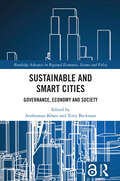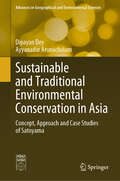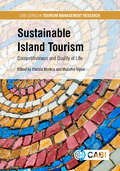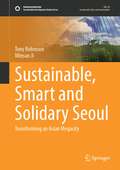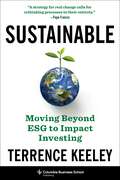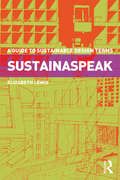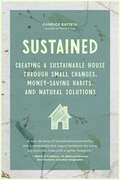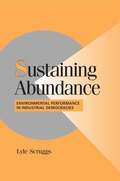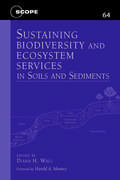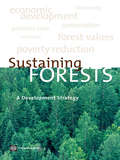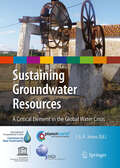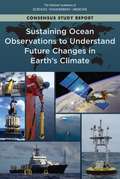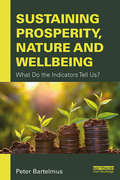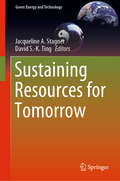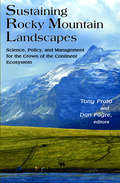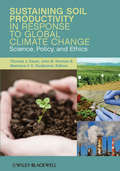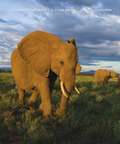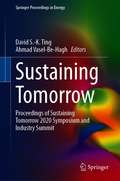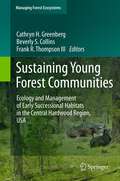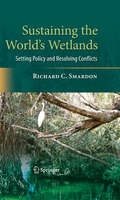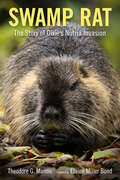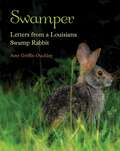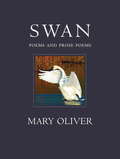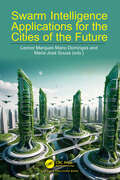- Table View
- List View
Sustainable and Smart Cities: Governance, Economy and Society (Routledge Advances in Regional Economics, Science and Policy)
by Anshuman Khare Terry BeckmanThis book provides a comprehensive overview of the challenges modern cities face in the context of climate change and urban development. By integrating varied viewpoints, it delves into the concept of sustainable and smart cities and sheds light on the opportunities for innovative and effective solutions, underscoring the interconnected nature of urban challenges and the necessity of a holistic approach.Contributors present diverse perspectives and methodologies, including empirical studies, modelling, simulation, policy analysis, and case studies, to offer insights into innovative and effective solutions for urban sustainability challenges. Chapters are grouped according to themes of governance and management, economy, society, and technology. Topics covered include smart city governance models, the enabling role of managers in sustainability efforts, resilient infrastructure, homelessness, and smart technology implementations. The book also identifies research gaps and areas of uncertainty, which may guide future research.With contributions from researchers across Asia, Europe, and North America, this book is a valuable resource for researchers in the areas of sustainable development, urban sustainability, and resilience research. It will also interest policymakers, practitioners, and stakeholders working towards addressing climate change in urban areas.An electronic version of this book is freely available, thanks to the support of libraries working with Knowledge Unlatched (KU). KU is a collaborative initiative designed to make high quality books Open Access for the public good. The Open Access ISBN for this book is 9781003518419. More information about the initiative and links to the Open Access version can be found at www.knowledgeunlatched.org.
Sustainable and Traditional Environmental Conservation in Asia: Concept, Approach and Case Studies of Satoyama (Advances in Geographical and Environmental Sciences)
by Ayyanadar Arunachalam Dipayan DeyThis book articulates the traditional Japanese concept of conservation, called Satoyama, for effective management of nature’s goods and services at a community–ecosystem interface in the climate milieu. The term Satoyama refers to socio-ecological production landscapes and seascapes, which are mosaics of diverse land uses and ecosystems that have long been shaped through sustainable human interactions with nature. This multilevel study of conservation science, therefore, serves an interdisciplinary academia, consistent with conventions on climate change, biodiversity and sustainable development, to establish links between conservation priorities and development objectives. In this book, the Satoyama is introduced as a rights-based neo-economic conservation paradigm for production-linked sustainable development, supplemented with case studies from Asia. The International Partnership for the Satoyama Initiative was established at the 10th Conference of the Parties to the Convention on Biological Diversity in 2010 to protect and revitalise Satoyama. However, even after a decade, this panacea for sustainability remains unfulfilled for practitioners and policy planners in the global south. Satoyama have been disappearing as a result of irresponsible consumption of natural resources and drastically changing agro-farming practices, threatening wildlife inhabiting those areas as well as the life and livelihood of marginal communities in the vicinity. In consideration of the global pandemic crisis, the present monograph aims for introspection within a traditional sustainable practice of Asia to augment community resilience and preparedness.
Sustainable island tourism: competitiveness, and quality-of-life
by Patrizia ModicaTourism continues to grow, and as the industry develops, it is important for researchers and practitioners to fully understand and examine issues such as sustainability, competiveness, and stakeholder quality of life in tourism centres around the world. Focusing on the unique perspective of island tourism destinations, this book outlines impacts on, and potential strategies for protecting, the natural environment, local economy, and local culture. Presenting an interdisciplinary integrated approach, this important collection of new research: - Is the first book to provide coverage on sustainable tourism best practice in island destinations; - Focuses on the unique perspective of islands as destinations, exploring the interplays of competitiveness and quality of life; - Includes a portfolio of conceptual, empirical, and case-based studies written by international experts to give a balanced and comprehensive view. A timely and important read for researchers, students and practitioners of tourism, this book also provides a valuable resource for researchers of sustainability and environmental science.
Sustainable, Smart and Solidary Seoul: Transforming an Asian Megacity (Sustainable Development Goals Series)
by Tony Robinson Minsun JiThis book showcases how innovative state policy in Korea transformed Seoul from one of the world’s most impoverished, polluted, and congested cities into a global leader in green urban planning, smart city innovations, and social economy initiatives that have dramatically improved the local quality of life. Today, Seoul’s urban planning innovations are increasingly touted as replicable best practices for export to cities across the globe.This book describes how innovative state policy has made Seoul a world leader in sustainable, smart, and solidary urban initiatives. Beginning in the 1960s, Seoul led the fastest urbanization and modernization project in world history, becoming a colossal 26-million-person metropolitan region and one of the largest footprints of humanity on earth, transforming the nation from one of the world’s poorest to having the 10th largest GDP in 2020.Today, Seoul has become one of the most productive and innovative urban agglomerations on earth. Seoul’s residents enjoy the world’s highest penetration of high-speed internet, a model mass transit system, and advanced smart-city technologies. The vast city has become increasingly green and sustainable, while also recycling about 90% of all waste. Seoul has become a leader in social economy innovations like cooperative villages, mutual benefit societies, and social investment funds that advance equitable development goals amid a booming capitalist economy. To broaden our imagination of what good urbanism can achieve, this book reviews Seoul’s recent innovations in smart, sustainable, and solidary urbanism, including: green urban planning, sustainable development through recycling and reuse, well-managed mass transit, smart city design, and solidarity economy initiatives.
Sustainable: Moving Beyond ESG to Impact Investing
by Terrence KeeleyShould business and finance play larger roles in resolving the great social and environmental challenges of our time? Proponents of environmental, social, and governance (ESG) investing say yes. They argue that ESG financial strategies can help reverse runaway carbon emissions and fix income and gender inequalities, among other ills. ESG-integrated investments already encompass more than $120 trillion in financial assets. Are they working as promised? If not, how can they be improved?In Sustainable, a finance-industry veteran offers an insider’s look at the promises, prospects, and perils of ESG investing. Terrence Keeley argues that many ESG advocates have been overly optimistic about what it can accomplish. Divestment threats are ineffective tools for altering corporate behavior, and verifiably “good” companies do not systematically generate great returns. Most importantly, business and finance cannot cure social ills on their own: regulators, public policies, civil society, and individuals must all play specific, complementary roles to shape the future we want. Keeley provides comprehensive solutions that would promote more inclusive, sustainable growth. In particular, he recommends reallocating capital from some indexed products toward an emerging class of strategies with more verifiable social and environmental benefits. Keeley identifies dozens of alternative “impact investing” strategies that could generate true double bottom lines. He also highlights promising civic organizations with proven methodologies for achieving widely shared benefits at scale.Proposing practical, actionable, and in many cases profitable solutions to social and environmental problems, Sustainable offers an incisive vision of the roles business and finance can and should play in building a flourishing society.
Sustainaspeak: A Guide to Sustainable Design Terms
by Elizabeth LewisArchitecture 2030; BUG; Biophilic Design; BIPV; Circular Economy; LEED; Passive Design; Solar Chimney; Systems Thinking; WELL; Xeriscaping. What does it all mean? The complex and evolving language used in the sustainable design community can be very challenging, particularly to those new to environmentally friendly and resource-efficient design strategies that are needed today. Definitions of over two hundred terms with further sources. Clearly cross-referenced with Sustainaspeak, Theoryspeak, and Archispeak terms. Illustrated throughout with sustainable award-winning buildings by e.g. Behnisch, Brooks + Scarpa, EHDD, KieranTimberlake, Lake|Flato, Leddy Mahtum Stacy, SmithGroup, Perkins+Will, ZGF, VMDO, and McDonough + Partners. Sustainaspeak: A Guide to Sustainable Design Terms provides a current guide to the sustainable design strategies, terms, and practices needed for the next generation of designers, architects, students, and community leaders to design a carbon-neutral world for future generations.
Sustained: Creating a Sustainable House Through Small Changes, Money-Saving Habits, and Natural Solutions
by Candice BatistaHelp Save Our Planet with Money-Saving Sustainable Tips for Your HouseHouseholds are among the biggest contributors to global greenhouse gas emissions worldwide. Could the secrets of saving the environment (and money) be closer to home than we thought?Looking for easy, budget-friendly ways to reduce your environmental impact and save money? Authored by award-winning environmental journalist, Candice Batista, Sustained takes you on an eye-opening journey towards sustainability and eco-friendly living─starting at home. This step-by-step, eco-living guide offers simple yet powerful ways to turn each room in your home into a hub of sustainability, while pocketing impressive savings every step of the way.Small changes, big impact. Starting with a deep dive into how our actions at home impact the planet, Sustained offers a practical suite of never-before-seen tools and solutions to initiate the shift towards a greener lifestyle–without draining your time, energy, or budget.Inside find:Eye-Opening Ideas: Explore green cleaning alternatives, ethical fashion brand recommendations, kitchen composting and waste management advice, laundry routine overhaul guidance, and more.Cleaner and Greener: Reduce your dependence on chemical products and single-use plastics, decipher cryptic food and fashion labels, shop like an eco-pro, and make room for a new lifestyle that’s kinder to you, your pocket, and the planet.Eco-Living Simplified: Going green doesn’t have to push your bank account into the red. Uncover tried-and-trusted tips for sustainable living, fresh recipe ideas, and up-to-date insights into top-rated biodegradable home products.Environmentally conscious readers of sustainability books like Simply Living Well, The Backyard Homestead Bible, or Sustainable Minimalism, will love Candice Batista's Sustained.
Sustaining Abundance: Environmental Performance in Industrial Democracies (Cambridge Studies in Comparative Politics)
by Lyle ScruggsThe ultimate goal of environmental policy is reducing pollution. Attention to environmental problems in the social sciences has brought some bold generalizations about causes of good results, but almost no systematic cross-national studies that flesh out major theoretical arguments and test those claims with data. This study makes a seminal contribution to that effort in two ways. First, by taking environmental outcomes over the last thirty years as the central dependent variable, it provides a basis for evaluating national performance in reducing environmental problems. Second, by developing a data set including performance in a number of countries and elaborating on major explanations of environmental performance found in the literature, this study provides the most rigorous available analysis of the determinants of environmental performance. In so doing, it challenges what is probably the conventional wisdom in the social sciences.
Sustaining Biodiversity and Ecosystem Services in Soils and Sediments (SCOPE Series #64)
by Diana H. WallSustaining Biodiversity and Ecosystem Services in Soils and Sediments brings together the world's leading ecologists, systematists, and evolutionary biologists to present scientific information that integrates soil and sediment disciplines across terrestrial, marine, and freshwater ecosystems. It offers a framework for a new discipline, one that will allow future scientists to consider the linkages of biodiversity below-surface, and how biota interact to provide the essential ecosystemservices needed for sustainable soils and sediments.Contributors consider key-questions regarding soils and sediments and the relationship between soil- and sediment- dwelling organisms and overall ecosystem functioning. The book is an important new synthesis for scientists and researchers studying a range of topics, including global sustainability, conservation biology, taxonomy, erosion, extreme systems, food production, and related fields. In addition, it provides new insight and understanding for managers, policymakers, and others concerned with global environmental sustainability and global change issues.
Sustaining Forests: A Development Strategy
by World BankThe World Bank's Forests Strategy, adopted in October 2002, charts a path for the Bank's proactive engagement in the sector to help attain the goal of poverty reduction without jeopardizing the environmental values intrinsic to sustainability. This strategy replaces the Bank's 1991 Forestry Strategy, and was developed on the basis of the findings of an independent review of the 1991 strategy and a two-year consultative process with development partners and stakeholders around the world. The revised strategy, Sustaining Forests, is built on three guiding pillars: harnessing the potential of forests to reduce poverty, integrating forests into sustainable economic development, and protecting global forest values. Recognizing the key role forests play in contributing to the livelihoods of people living in extreme poverty, government and local ownership of forest policies and interventions are emphasized along with the development of appropriate institutions to ensure good governance and the mainstreaming of forests into national development planning. The strategy also aims to support ecologically, socially and economically sound management of production forests by ensuring good management practices through application of safeguard procedures and independent monitoring and certification. Implementation of the strategy will center on building and strengthening partnerships with the private sector, non-governmental organizations, and other donor agencies to promote better forest conservation and management at country and global levels.
Sustaining Groundwater Resources
by J. Anthony JonesBurgeoning population and climate change are among the most critical challenges facing the 21st century. Both have critical implications for groundwater resources, especially in many developing countries where resources are already under pressure. Due to low rainfall and high evaporation in parts of the Middle East and North Africa, groundwater is not being renewed, and groundwater laid down up to 10,000 years ago is literally being mined for irrigation, often very inefficiently. Over recent decades, groundwater levels have fallen dramatically in key grain-growing regions like the American Great Plains and the North China Plain. As the population grows and emerging economies like China and India demand more food, especially water intensive meat products, agricultural demand for water is set to increase. The rapid shift of population from the countryside to the cities is also adding to this pressure; most old wells in Beijing are now dry. Pollution from industry, agriculture and shanty towns is destroying many groundwater resources; some could take 50 years to clean up even with strict and immediate controls. This volume looks at the technical, socio-economic and political problems being faced, and at the developments in groundwater science and management that may help create a sustainable future for our planet.
Sustaining Ocean Observations to Understand Future Changes in Earth’s Climate
by Engineering Medicine National Academies of SciencesThe ocean is an integral component of the Earth’s climate system. It covers about 70% of the Earth’s surface and acts as its primary reservoir of heat and carbon, absorbing over 90% of the surplus heat and about 30% of the carbon dioxide associated with human activities, and receiving close to 100% of fresh water lost from land ice. With the accumulation of greenhouse gases in the atmosphere, notably carbon dioxide from fossil fuel combustion, the Earth’s climate is now changing more rapidly than at any time since the advent of human societies. Society will increasingly face complex decisions about how to mitigate the adverse impacts of climate change such as droughts, sea-level rise, ocean acidification, species loss, changes to growing seasons, and stronger and possibly more frequent storms. Observations play a foundational role in documenting the state and variability of components of the climate system and facilitating climate prediction and scenario development. Regular and consistent collection of ocean observations over decades to centuries would monitor the Earth’s main reservoirs of heat, carbon dioxide, and water and provides a critical record of long-term change and variability over multiple time scales. Sustained high-quality observations are also needed to test and improve climate models, which provide insights into the future climate system. Sustaining Ocean Observations to Understand Future Changes in Earth’s Climate considers processes for identifying priority ocean observations that will improve understanding of the Earth’s climate processes, and the challenges associated with sustaining these observations over long timeframes.
Sustaining Prosperity, Nature and Wellbeing: What do the Indicators Tell Us?
by Peter L.P. BartelmusThis book explores what is needed for an overall evaluation of the prosperity and wellbeing of people within a framework of sustaining the economy, environment and development. The book begins by assessing the validity of available data, indicators and indices in decision and policy making. It describes what the data tell us about the effects of economic activity on the quality of life and prosperity of people and nations, now and in the future, and highlights how a reliance on partial and distorted information can thwart rational policies. It also examines whether less tangible notions of wellbeing and happiness lend themselves to quantification and prediction. Overall, Bartelmus demonstrates the need for integrated accounting and analysis to revise policy priorities around environmental, social, economic and sustainability concerns. Confronting the persisting polarization of environmentalists and economists, this book will be of great relevance to students, scholars and professionals with an interest in environmental and ecological economics, sustainability indicators and their use in integrative policy.
Sustaining Resources for Tomorrow (Green Energy and Technology)
by David S.-K. Ting Jacqueline A. StagnerThis book reflects the current state of knowledge on sustainability in a wide range of fields, from engineering to agriculture, to education. Though primarily intended to offer an update for experts and researchers in the field, it can also be used as a valuable educational tool for relevant undergraduate and graduate courses. Key aspects covered include the better and more responsible engineering and management of energy conversion processes, the development of renewable energy technologies, and improvements in conventional energy utilization and food production. In addition, the book addresses green buildings, the green economy, waste and recycling, water, ecopolitics and social sustainability.
Sustaining Rocky Mountain Landscapes: Science, Policy, and Management for the Crown of the Continent Ecosystem
by Tony Prato Dan FagrePrato and Fagre offer the first systematic, multi-disciplinary assessment of the challenges involved in managing the Crown of the Continent Ecosystem (CCE), an area of the Rocky Mountains that includes northwestern Montana, southwestern Alberta, and southeastern British Columbia. The spectacular landscapes, extensive recreational options, and broad employment opportunities of the CCE have made it one of the fastest growing regions in the United States and Canada, and have lead to a shift in its economic base from extractive resources to service-oriented recreation and tourism industries. In the process, however, the amenities and attributes that draw people to this 'New West' are under threat. Pastoral scenes are disappearing as agricultural lands and other open spaces are converted to residential uses, biodiversity is endangered by the fragmentation of fish and wildlife habitats, and many areas are experiencing a decline in air and water quality. Sustaining Rocky Mountain Landscapes provides a scientific basis for communities to develop policies for managing the growth and economic transformation of the CCE without sacrificing the quality of life and environment for which the land is renowned. The book begins with a natural and economic history of the CCE. It follows with an assessment of current physical and biological conditions in the CCE. The contributors then explore how social, economic, demographic, and environmental forces are transforming ecosystem structure and function. They consider ecosystem change in response to changing patterns of land use, pollution, and drought; the increasing risk of wildfire to wildlife and to human life and property; and the implications of global climate change on the CCE. A final, policy-focused section of the book looks at transboundary issues in ecosystem management and evaluates the potential of community-based and adaptive approaches in ecosystem management.
Sustaining Soil Productivity in Response to Global Climate Change: Science, Policy, and Ethics
by Thomas J. Sauer John M. Norman Mannava V. K. SivakumarSustaining Soil Productivity in Response to Global Climate Change: Science, Policy, and Ethics is a multi-disciplinary volume exploring the ethical, political and social issues surrounding the stewardship of our vital soil resources. Based on topics presented by an international group of experts at a conference convened through support of the Organization for Economic Co-operation and Development, chapters include scientific studies on carbon sequestration, ecosystem services, maintaining soil fertility, and the effects of greenhouse gas emissions, as well as ethical issues ranging from allocation of land use to policies needed for climate change adaptation and mitigation. Bringing together the latest research in soil science and climatology, Sustaining Soil Productivity in Response to Global Climate Change is a valuable resource for soil and plant scientists, agronomists and environmental scientists, as well as agricultural and natural resources engineers and economists, environmental policy makers and conservationists. Key Features: Written by an international group of authors representing a cross-section of scientists, thought leaders, and policy-makers Includes chapters on the potential effects of climate change on forest soil carbon, microbial function, and the role of soils and biogeochemistry in the climate and earth system Explores historical development of land use ethics and stewardship
Sustaining The Earth
by Scott Spoolman G. MillerSUSTAINING THE EARTH provides the basic scientific tools for understanding and thinking critically about the environmental problems we face. About half the price of other environmental science texts, this 14-chapter, one-color core book offers an integrated approach that emphasizes how environmental and resource problems and solutions are related. The new edition of SUSTAINING THE EARTH is fully updated with the latest statistics and reports of important scientific studies. New Connections boxes show surprising but important connections between environmental problems and aspects of daily life. In addition, new Thinking About boxes help students apply the concepts of the book to their own lives. Sustainability is the integrating theme of this current and thought-provoking book. The concept-centered approach transforms complex environmental topics and issues into key concepts that students will understand and remember. By framing the concepts with goals for more sustainable lifestyles and human communities, students see how promising the future can be.
Sustaining Tomorrow: Proceedings of Sustaining Tomorrow 2020 Symposium and Industry Summit (Springer Proceedings in Energy)
by David S.-K. Ting Ahmad Vasel-Be-HaghThis book includes the proceedings of the Sustaining Tomorrow 2020 symposium and summit which bring together research from experts in academia, industry, and policy arenas to uncover the challenges and to forge solutions to sustain tomorrow. To sustain tomorrow, we need to continuously make headway in Agriculture, Engineering, Energy, Environment, Economics, Water, among other necessities. This book disseminates the most recent advances in these fields and promotes collaborations to maximize opportunities for innovative solutions.Though primarily intended to offer an update for experts and researchers in the field, this book is equally useful as a valuable educational tool for relevant undergraduate and graduate courses. Key aspects covered include the better and more responsible engineering and management of energy conversion and conservation processes, the furthering of renewable energy technologies, improvements in water-agriculture nexus and energy-environment-economics relationship, and endorsing education, implementation, and evaluation of all-embracing sustainability.
Sustaining Young Forest Communities
by Beverly Collins Frank Thompson III Cathryn GreenbergThis edited volume addresses a rising concern among natural resource scientists and management professionals about decline of the many plant and animal species associated with early-successional habitats, especially within the Central Hardwood Region of the USA. These open habitats, with herbaceous, shrub, or young forest cover, are disappearing as abandoned farmland, pastures, and cleared forest patches return to forest. There are many questions about "why, what, where, and how" to manage for early successional habitats. In this book, expert scientists and experienced land managers synthesize knowledge and original scientific work to address questions on such topics as wildlife, water, carbon sequestration, natural versus managed disturbance, future scenarios, and sustainable creation and management of early successional habitat in a landscape context.
Sustaining the World's Wetlands
by Richard SmardonWritten both as a textbook and as a professional reference book, Sustaining the World's Wetlands: Setting Policy and Resolving Conflicts contains detailed case studies of wetland management worldwide. Examinations of international wetland policy in Europe, Africa, Asia, and North America generate a discussion of the differences between wetland management issues in developed and developing countries, and culminate in suggested strategies for the future of wetland management. Key themes addressed in the case studies include the tradeoffs between sustainable use of wetlands for food, fuel, and fiber vs. the protection of ecosystem diversity and stability, and the respective roles of big international NGO's, national and regional government, and local community-based organizations when faced with wetland management issues. With its global scope and its emphasis on policy and management analysis, Sustaining the World's Wetlands is a unique and valuable tool both for students and for practitioners.
Swamp Rat: The Story of Dixie's Nutria Invasion (America's Third Coast Series)
by Theodore G. MannoTheodore G. Manno traces the history of nutria from their natural range in South America to their status as an invasive species known for destroying the environmentally and economically important wetlands along the Gulf Coast. In this definitive book on “swamp rats,” Manno vividly recounts western expansion and the explosion of the American fur industry. Then he details an apocalyptic turn—to replace an overhunted beaver population in North America, humans introduced nutria. With an eclectic repertoire of true stories that read like fiction and are played out by larger-than-life characters, Manno conveys the legend of empire-seeking fur trappers, the bizarre miscommunications that led to nutria releases, and the sadness that comes with killing millions of nutria whose ancestors were never meant to leave their South American habitat. He tells of disastrous interactions among hungry nutria, storm surges from Hurricane Katrina, and major oil spills. His extensively researched and epic narrative, accompanied by more than thirty photographs and entertaining interviews with biologists, historians, fashion designers, and chefs, weaves a poignant tale of empire, conquest, fortune, and even Tabasco Sauce. Manno provides a full overview of what is currently known about nutria—a species now aggressively hunted with a bounty program because of their reputation for wetland destruction.
Swamper: Letters from a Louisiana Swamp Rabbit
by Amy Griffin OuchleySwamper, a fictitious swamp rabbit, lives in the bottomland hardwood forest, or overflow swamp, which is a very real environment. In twelve "letters" addressed to his human friends, Swamper shares his vivid observations about life in a Louisiana swamp. With excitement and captivating detail, he explains ecological concepts such as food webs, energy flow, decomposition, and reproduction. He recounts adventures like escaping his predators, the great horned owl and the red fox, and swimming for his life after a flood forces him to find higher ground. The alert swamp rabbit even describes the seasonal migration of birds and the monthly phases of the moon. While educating students about the interconnected life cycles found in a natural habitat, Swamper's first-hand account of the richness and value of the wetlands will also help young readers develop a deeper appreciation for this delicate ecosystem. Though written for all ages to enjoy, the content specifically aligns with life science and environmental science educational standards for 4th through 7th grades. Also Includes:A glossary of key termsQuestions and a creative activity for each letterBiologically accurate drawings of animals and habitatColor photographs of the environmentSupplementary online resources for teachers and parents
Swamplife: People, Gators, and Mangroves Entangled in the Everglades (A Quadrant Book)
by Laura A. OgdenLittle in North America is wilder than the Florida Everglades—a landscape of frightening reptiles, exotic plants in profusion, swarms of mosquitoes, and unforgiving heat. And yet, even from the early days of taming the wilderness with clearing and drainage, the Everglades has been considered fragile, unique, and in need of restorative interventions. Drawing on a decade of fieldwork with hunters in the Everglades, Laura A. Ogden explores the lives and labors of people, animals, and plants in this most delicate and tenacious ecosystem.Today, the many visions of the Everglades—protectionist, ecological, commercial, historical—have become a tangled web of contradictory practices and politics for conservation and for development. Yet within this entanglement, the place of people remains highly ambivalent. It is the role of people in the Everglades that interests Ogden, as she seeks to reclaim the landscape&’s long history as a place of human activity and, in doing so, discover what it means to be human through changing relations with other animals and plant life. Ogden tells this story through the lives of poor rural whites, gladesmen, epitomized in tales of the Everglades&’ most famous outlaws, the Ashley Gang. With such legends and lore on one side, and outsized efforts at drainage and development on the other, Swamplife strikes a rare balance, offering a unique insight into the hidden life of the Everglades—and into how an appreciation of oppositional culture and social class operates in our understanding of wilderness in the United States.
Swan
by Mary OliverWidely regarded as the "rock star" of American poetry, Mary Oliver is a writer whose words have long had the power to move countless readers. Regularly topping the national poetry best-seller list and drawing thousands to her sold-out readings across the coutnry, Oliver is unparalleled in her impact. As noted in the Los Angeles Times, so many "go to her for solace, regeneration and inspiration" that it is not surprising Vice President Joe Biden chose to read one of her poems during the 9/11 remembrance at Ground Zero. Few poets express the complexities of human experience as skillfully as Mary Oliver. This volume, Oliver's twenty-first book of poetry, contains all new poems on her classic themes. Here, readers will find the deep spiritual sustenance that imbues her writing on nature, love, mortality, and grief. As always, Oliver is an accomplished guide to the rarest and most exquisite insights of the natural world. Ranking "among the finest poets the English language has ever produced," according to the Weekly Standard, Oliver offers us lyrics of great depth and beauty that continue her lifelong work of loving the world.
Swarm Intelligence Applications for the Cities of the Future
by Maria José Sousa Leonor Marques Mano DomingosThis book explores the transformative power of swarm intelligence and digital innovations in shaping the cities of the future. It presents a comprehensive analysis of how social learning, citizen engagement, advanced technology, design, construction, planning and public policies converge to create cities that are sustainable, resilient, and inclusive.The initial chapters stress the importance of collective intelligence in urban development, using technologies like Virtual Reality to increase citizen participation and democratise decision-making. Public policies play a key role in driving the digital transformation needed for greener cities, with frameworks and tools to enhance transparency and accountability. Digital technologies in policymaking ensure that policies are adaptive, data-driven, and responsive to real-time challenges. Internet of Things systems are explored for their role in improving public safety, urban resilience, and energy efficiency through digital twins, blockchain, and sensor networks. Swarm intelligence is highlighted for optimising energy management, reducing consumption, and promoting renewable resources. Healthcare integration into urban planning and sustainability is also discussed, with a comparative analysis of cities showing how tech innovation enhances resilience against climate change. Swarm intelligence beyond cities is also explored, such as for disaster response, healthcare, environmental conservation, and agriculture. Autonomous systems like drones and nanobots are shown to improve efficiency across various sectors.Overall, this book advocates for a holistic approach to urban development, integrating digital technologies and collective intelligence to create cities that are technologically advanced, socially equitable, and environmentally sustainable.
